Be aware of erosion, bluff stability

Above-average lake levels, shoreline erosion, weather events reasons for property owners to stay aware of hazards, risks
Lake Huron is below record level but higher than average; high water combined with wet ground, natural hazards, pose risks of more gully and bluff erosion; slope failure
Lake levels are the highest they have been in years. These higher-than-average lake levels, combined with rain, high winds and wave action lead to erosion at the base of the bluffs and an increase in gully erosion in some areas. This in turn can lead to risk of slope failures along the lakeshore.
“Property owners should remain aware of natural hazards and risks along the shoreline and monitor their property regularly for any sign of potential slope failure or bluff collapse,” said Geoff Cade, Water and Planning Manager with Ausable Bayfield Conservation Authority (ABCA). “It is very difficult to predict when bluff failures might happen or how big those failures could be.”
Property owners should regularly check the condition of their bluff and property and if they have any concerns, to seek advice from appropriately qualified engineering and technical professionals. In the event of a significant bluff or slope failure that impacts residential structures, property owners should notify their municipality and the conservation authority immediately.
One resource for shoreline property owners is a fact sheet about Shoreline Slope Stability Risks and Hazards. Ausable Bayfield Conservation contracted Terraprobe Inc. to create this fact sheet. It is available online at abca.ca. You may download a free PDF copy of this fact sheet now at this link:
The fact sheet includes indicators of potential bluff instability and associated risks; best management practices (BMPs) for bluff stability and shoreline areas; and sources of additional information. The fact sheet includes typical signs of slope instability; recommended management practices (Dos and Don’ts along the shoreline); definitions of cohesive shorelines and shoreline recession; among other shoreline information.
Higher water levels and wet weather add to the inherent natural hazards and risks that exist along shorelines, according to ABCA. Rain, storm melt, and runoff are among contributors to erosion and potential bluff failure. Precipitation totals, calculated from automated rain gauges, show that rainfall over the past 12 months has been approximately 20 per cent higher than normal for shoreline areas. So far, in 2018, as of late April, rainfall in the same area is double the normal expected amounts for this time of year.
Much of the Lake Huron shoreline is bluff. Bluff material is made of silt, clay, sand and small rock and was first deposited by glaciers. This is known as a cohesive shoreline. Erosion of this material by Lake Huron has created the tall bluffs. These shoreline bluffs have been eroding for thousands of years and continue to be subject to wave action at their toe or base. This leads to cycles of erosion and slope instability. This, in turn, results in recession or erosion at the top of the slope. The wave action undercuts and locally over-steepens the slope toe.
Factors affecting bluff erosion include wave action, lake levels, groundwater flow and saturation, wind, freeze-thaw cycles, bluff height, soil type, and the angle of the bluff. Heavy rainfall and freeze-thaw cycles, over the winter and spring, increase the potential for erosion along the Lake Huron shoreline. Saturated clay-till bluffs, combined with erosion from wind, storm events, and higher lake levels, can lead to increased slope instability along the shoreline and increased erosion of gullies.
Water levels in Lake Huron are above the long-term average and higher than this time last year. Lake water levels are, in fact, higher than they have been since 1998 and they have rebounded from the period of lower-than-average levels that took place between late 1999 and early 2014. Lake Huron has not experienced, in recent years, the record-setting water levels seen in other lakes of the Great Lakes-St. Lawrence Basin. Water levels are above average and above Chart Datum, however, even if they are not outside the standard range of variation in the Huron-Michigan system. It is predicted that water levels in Lake Huron will remain above average through the summer even if weather conditions are fairly dry.
Bluff erosion is a natural process that has been occurring along the Great Lakes shorelines since they were formed more than 10,000 years ago. This erosion process is necessary to the ecology of the shorelines as sand beaches would disappear without some erosion. However, with higher lake levels, combined with rain and snow events, the erosion process is more visible. Property owners need to be aware of the increased erosion and slope failure potential and watch for any sign of slope failure on their property. Property owners can contact their local conservation authority with questions.
